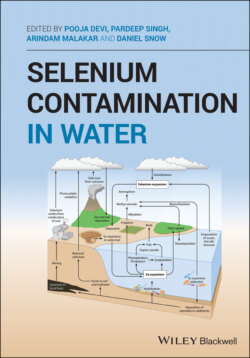Читать книгу Selenium Contamination in Water - Группа авторов - Страница 64
4.4 Control Measures of Selenium Toxicity
ОглавлениеAll of the previous reports have mentioned that Se toxicity could reduce livestock farming industry production in any country. Mapping of agricultural land based on the presence of compulsory and optional Se accumulator plants and non‐accumulator plants is the ultimate control measure method (de Souza et al. 1999; Barillas et al. 2011; White 2016; Gupta and Gupta 2017; Schiavon and Pilon‐Smits 2017). It will help to decide the measure of grazing land and actively manage the toxicity of Se in the soil. Before applying forage plants to animals of livestock or any other supplements these should be subjected to determination of the level of Se. Both of these preventive steps would potentially minimize the intake of Se in livestock (Tiwary et al. 2006). Transgenic plants have the potential to remove Se from soil (Pilon‐Smits and LeDuc 2009). Apart from these etiological preventive steps, some studies stated that the amount of animal blood Se can be a great predictor for earlier determination of signs linked to Se toxicity. The presence of >1.5 μg/ml in cattle blood has been reported to be indicative of the onset of Se toxicity (Deore et al. 2002).
Preventive measures such as soil treatment, high protein‐rich feed feeding, dietary sulfate, methionine supplement, linseed meal, spraying sulfur‐containing materials on fodders grown in selenium‐rich soil, clean water, etc. may reduce selenosis (Prakash et al. 2010; He et al. 2018; Wadgaonkar et al. 2018). To date, no particular studies have ever reported absolute attenuation of Se toxicity in animals as a result of the procedure. The study on intravenous administration of reduced glutathione (GSH) @ 5 mg/kg of BW was useful in arresting the Se toxicity after decreasing the activity of glutathione peroxidase (GSH‐Px) (Deore et al. 2005). The study of Arora et al. (1975) and Arora (1985) reported that trace mineral mixture which includes 1 kg of magnesium sulfate (MgSO4), 166 g of ferrous sulfate (FeSO4), 24 g of copper sulfate (CuSO4), 75 g of zinc sulfate (ZnSO4), and 15 g of cobalt sulfate (CoSO4) was a great help in recovering the Se toxicity in buffaloes after 21 days of exposure and within 50 days. One research recorded that both arsanilic acid (0.02%) and 3‐nitro (0.005%) were similarly successful in preventing selenosis in pigs. These chemicals also had positive effects on weight gain as the control pigs developed between 67 and 100 pounds per pig (Wahlstrom et al. 1956). Se toxicity was also minimized by a protein‐rich diet and mineral balance mixture in buffaloes (Fessler et al. 2003). Increasing horse grazing time to 50% on pasture significantly reduced Se concentration compared to those horses that had less pasture time (Crisman et al. 1994). The same pattern emerged in water buffaloes (Khanal and Knight 2010).
Seleniferous soil is the primary component in the food chain which transfers the higher levels of Se. Adding sulfur decreases the plant supply Se in soil. One piece of research suggested that the introduction of 1000 kg gypsum/ha in sugar cane increased the S:Se ratio and decreased the Se amount (Dhillon and Dhillon 1991). Continuous application of S can result in plant selenium deficiency, and eventually there will be trouble for domestic animals (Andrews et al. 1968; McDonald 1975; Fessler et al. 2003). One phytoremediation technique was reported to reduce the level of Se in soil, where it was claimed that kenaf and canola planting in seleniferous soil had scavenged the Se from soil and water (Wood 2000).
Carbohydrate‐rich diets, protein, sulfate, and calcium in cattle decreased Se levels (Kessler 1993). Concentration above 2.4 g/kg DM of sulfur decreased Se absorption substantially (Spears and Weiss 2008). Administration of 0.8% calcium DM in feed significantly decreases Se in pregnant cows' blood and muscle (Harrison et al. 1983).
Vitamin E administration can reduce the toxicity to Se in cattle (NRC 1996). One study suggested that the use of vitamin E in dairy cattle with 15–60 foreign units (IU) decreases Se (NRC 1984, 1996).
